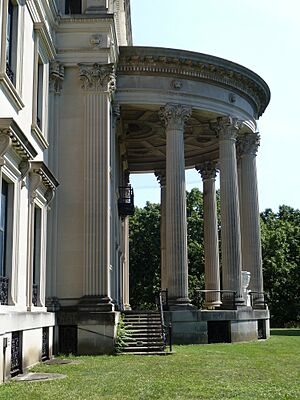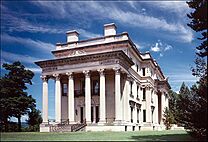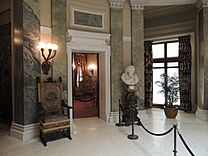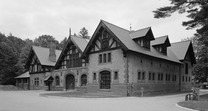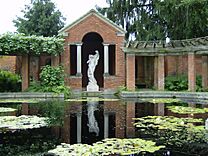Vanderbilt Mansion National Historic Site facts for kids
|
Vanderbilt Mansion National Historic Site
|
|
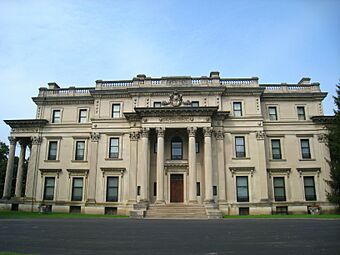
East facade and main entrance
|
|
| Location | Hyde Park, New York |
|---|---|
| Area | 211 acres (85 ha) |
| Built | 1896–99 |
| Architect | McKim, Mead & White, Robert H. Robertson |
| Architectural style | Beaux-Arts |
| Visitation | 372,517 (2005) |
| Website | Vanderbilt Mansion National Historic Site |
| NRHP reference No. | 66000059 |
Quick facts for kids Significant dates |
|
| Added to NRHP | October 15, 1966 |
| Designated HD | October 15, 1966 |
| Designated NHS | December 18, 1940 |
The Vanderbilt Mansion National Historic Site is a really cool historic house museum. You can find it in Hyde Park, New York, in the United States. It became a special National Historic Landmark in 1940. Today, the National Park Service takes care of it.
This amazing property was once known as Hyde Park. It was one of many homes owned by Frederick William Vanderbilt and his wife, Louise Holmes Anthony. The huge 54-room mansion was designed by a famous architecture team called McKim, Mead & White. It was built between 1896 and 1899. The house shows off the beautiful Beaux-Arts architecture style. Inside, you'll see a mix of old European pieces, antiques, and fancy reproductions. The site covers 211 acres (85 ha) of land. It sits on a hill overlooking the Hudson River. You can explore pretty lawns, formal gardens, woods, and many other buildings there.
Contents
A Look at the Mansion's History
The Vanderbilt Mansion has a long history. It is one of the oldest estates along the Hudson River. The first development on the land started in 1764. Dr. John Bard bought the land and built a house called Red House. He also started farming on the eastern part of the property. The Bard family owned the land until 1821.
Later, in 1828, Dr. David Hosack bought the property. He was the president of the New York Horticultural Society. He even had help from André Parmentier to design the beautiful grounds. In 1840, John Jacob Astor bought the estate for his daughter and her husband. Their son, Walter, lived there until he passed away in 1894.
How the Vanderbilts Made it Their Own
Frederick and Louise Vanderbilt bought Hyde Park in May 1895. They loved the Hudson Valley and the land by the river. Frederick and his wife settled into their large 600-acre (240 ha) estate. The location was perfect because it offered quick trips to New York City. They could even use the Vanderbilt's own New York Central Railroad.
The mansion was designed and built from 1896 to 1899. It was mainly used as a vacation home for the Vanderbilt family. The previous owners had already made the estate famous for its grand landscape. It had many different plants and trees. The New York Times newspaper even called the Vanderbilt estate "the finest place on the Hudson."
When Frederick Vanderbilt passed away in 1938, his niece, Margaret "Daisy" Van Alen, inherited the property. President Franklin D. Roosevelt lived nearby and encouraged her. In 1940, Van Alen gave part of the estate to the National Park Service. This included the mansion with most of its original furniture. During World War II, from 1941 to 1943, President Roosevelt's Secret Service used the basement and third floor. Some of the President's staff and friends also stayed in the main bedrooms.
Exploring the Mansion
The mansion has 54 rooms and was designed by McKim, Mead & White. Charles Follen McKim created the main plan in the Beaux-Arts style. Stanford White helped by finding antique items for the house.
The house has a classic Beaux-Arts layout. The main public rooms are on the ground floor. These include the Elliptical Hall, Dining Room, and Living Room. They all line up, facing the Hudson River. There are also smaller spaces like the Lobby and Den.
Upstairs, on the second floor, you'll find Mrs. Vanderbilt's private rooms. These include her Bedroom, Boudoir (a fancy sitting room), and Bathroom. Mr. Vanderbilt also had his own bedroom and bathroom. There are also guest bedrooms and a Linen Room. The third floor has five more guest bedrooms. It also has a Servants' Hall, separated from the guest rooms.
The Vanderbilt mansion was very modern for its time. It was built with concrete and steel. It also had plumbing, central heating, and electric lights. The electricity came from a special power plant on the estate. The Vanderbilt estate had electric lights before the surrounding area did!
The Carriage House and Gardens
The Vanderbilts decided to replace the old cow barns on their property. They chose Robert H. Robertson, a well-known architect. He also designed Shelburne Farms, which belonged to Frederick Vanderbilt's sister. Robertson's carriage house is in the Queen Anne style. It looks very different from the grand mansion.
Beautiful Italian Gardens
The Italian gardens are separate from the main house. They have a formal design, which means they are very neat and balanced. If you drew a line down the middle, one side would perfectly mirror the other. These gardens also have different levels, or tiers, for various plants. Each level looks unique. Frederick himself added a rose garden. It had almost 2000 old rose bushes, plus other kinds of roses.
See also
 In Spanish: Mansión Vanderbilt para niños
In Spanish: Mansión Vanderbilt para niños




